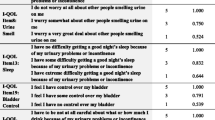Abstract
Introduction and hypothesis
As shorter recall periods are sometimes preferable to longer recall periods, the objective of this study was to evaluate the psychometric characteristics and measurement properties of the 1-week recall version of the Overactive Bladder Questionnaire (OAB-q).
Methods
Secondary analyses were performed on data for three 12-week clinical trials of fesoterodine. Patients completed the Patient Perception of Bladder Condition (PPBC), the Patient Perception of Urgency Scale (PPUS), and 3-day bladder diaries in addition to the OAB-q at baseline, 4 and 12 weeks. Analyses were conducted to evaluate the reliability, concurrent and discriminant validity and responsiveness of the OAB-q 1-week recall version.
Results
The patients in the three studies (Study 1: N = 516, Study 2: N = 441; Study 3: N = 882) had a mean age of 59.6, 59.4, and 59.9 years, respectively; and most of the patients were female (77.1%, 88.9%, and 82.9%) and White (76.6%, 90.0%, and 88.0%). Patients had been diagnosed with OAB for a mean of 5.2, 8.3, and 9.1 years, respectively. Cronbach’s alpha values were greater than 0.85 across all samples and subscales. Correlations between the 1-week recall version of the OAB-q and the PPBC, PPUS, and most of the bladder diary variables were moderate to strong. Discriminant validity of the OAB-q was good, with significant differences in mean OAB-q scores across all response categories of the PPUS. The OAB-q was highly responsive to changes in patients’ conditions as indicated by moderate to large effect sizes. The OAB-q 1-week recall version has a similar factor structure to the 4-week recall version with each subscale model demonstrating acceptable fit.
Conclusion
The 1-week recall version of the OAB-q appears to be reliable, valid, and responsive and is psychometrically equivalent to the 4-week recall version. The validation of the 1-week recall version offers researchers and clinicians an additional option for using the OAB-q.
Similar content being viewed by others
References
Abrams P (2003) Describing bladder storage function: overactive bladder syndrome and detrusor overactivity. Urology 62(5 Suppl 2):28–37, discussion 40–42
Haylen BT, de Ridder D, Freeman RM et al (2010) An International Urogynecological Association (IUGA)/International Continence Society (ICS) joint report on the terminology for female pelvic floor dysfunction. Neurourol Urodyn 29(1):4–20
Leidy NK, Revicki DA, Geneste B (1999) Recommendations for evaluating the validity of quality of life claims for labeling and promotion. Value Health 2(2):113–127
Coyne KS, Sexton CC, Irwin DE et al (2008) The impact of overactive bladder, incontinence and other lower urinary tract symptoms on quality of life, work productivity, sexuality and emotional well-being in men and women: results from the EPIC study. BJU Int 101(11):1388–1395
Stewart WF, Van Rooyen JB, Cundiff GW et al (2003) Prevalence and burden of overactive bladder in the United States. World J Urol 20(6):327–336
Homma Y, Gotoh M (2009) Symptom severity and patient perceptions in overactive bladder: how are they related? BJU Int 104(7):968–972
Stull DE, Leidy NK, Parasuraman B, Chassany O (2009) Optimal recall periods for patient-reported outcomes: challenges and potential solutions. Curr Med Res Opin 25(4):929–942
McColl E (2004) Best practice in symptom assessment: a review. Gut 53(Suppl 4):49–54
Wyrwich KW, Tardino VM (2004) A blueprint for symptom scales and responses: measurement and reporting. Gut 53(Suppl 4):45–48
FDA: Guidance for Industry. Patient-Reported Outcome Measures: Use in Medical Product Development to Support Labeling Claims. December 2009, U.S. Department of Health and Human Services, Food and Drug Administration, Silver Spring, MD, pp 1–39
Keller SD, Bayliss MS, Ware JE Jr et al (1997) Comparison of responses to SF-36 Health Survey questions with one-week and four-week recall periods. Health Serv Res 32(3):367–384
Barr JT, Schumacher GE, Freeman S et al (2000) American translation, modification, and validation of the St. George’s Respiratory Questionnaire. Clin Ther 22(9):1121–1145
Chapple CR, Khullar V, Gabriel Z et al (2008) The effects of antimuscarinic treatments in overactive bladder: an update of a systematic review and meta-analysis. Eur Urol 54(3):543–562
Vardy MD, Mitcheson HD, Samuels TA et al (2009) Effects of solifenacin on overactive bladder symptoms, symptom bother and other patient-reported outcomes: results from VIBRANT — a double-blind, placebo-controlled trial. Int J Clin Pract 63(12):1702–1714
Coyne K, Revicki D, Hunt T et al (2002) Psychometric validation of an overactive bladder symptom and health-related quality of life questionnaire: the OAB-q. Qual Life Res 11(6):563–574
Coyne KS, Matza LS, Kopp Z, Abrams P (2006) The validation of the patient perception of bladder condition (PPBC): a single-item global measure for patients with overactive bladder. Eur Urol 49(6):1079–1086
Kazis LE, Anderson JJ, Meenan RF (1989) Effect sizes for interpreting changes in health status. Med Care 27(3):S178–S189
Coyne KS, Matza LS, Thompson CL (2005) The responsiveness of the Overactive Bladder Questionnaire (OAB-q). Qual Life Res 14(3):849–855
Matza LS, Thompson CL, Krasnow J et al (2005) Test–retest reliability of four questionnaires for patients with overactive bladder: the overactive bladder questionnaire (OAB-q), patient perception of bladder condition (PPBC), urgency questionnaire (UQ), and the primary OAB symptom questionnaire (POSQ). Neurourol Urodyn 24(3):215–225
Matza LS, Zyczynski TM, Bavendam T (2004) A review of quality-of-life questionnaires for urinary incontinence and overactive bladder: which ones to use and why? Curr Urol Rep 5(5):336–342
Abrams P, Artibani W, Gajewski JB, Hussain I (2006) Assessment of treatment outcomes in patients with overactive bladder: importance of objective and subjective measures. Urology 68(2 Suppl):17–28
Brubaker L, Chapple C, Coyne KS, Kopp Z (2006) Patient-reported outcomes in overactive bladder: importance for determining clinical effectiveness of treatment. Urology 8(2 Suppl):3–8
Conflicts of interest
Karin Coyne, Heather Gelhorn, and Christine Thompson are employees of United BioSource Corporation, who are scientific consultants to Pfizer. Zoe Kopp and Zhonghong Guan are employees of Pfizer.
Author information
Authors and Affiliations
Corresponding author
Rights and permissions
About this article
Cite this article
Coyne, K.S., Gelhorn, H., Thompson, C. et al. The psychometric validation of a 1-week recall period for the OAB-q. Int Urogynecol J 22, 1555–1563 (2011). https://doi.org/10.1007/s00192-011-1486-0
Received:
Accepted:
Published:
Issue Date:
DOI: https://doi.org/10.1007/s00192-011-1486-0




